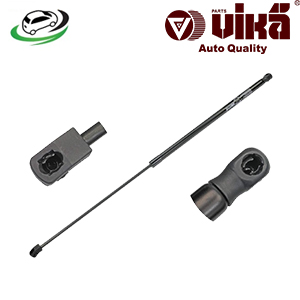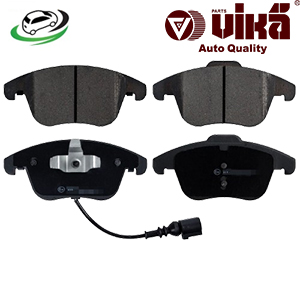Get Front Brake Pad Set AUDI Q3 8U/VW Tiguan 5N/Sharan 7N/Passat A32/Seat 710 5N0698151
Brake pads are a crucial component of a vehicle’s braking system. They are responsible for converting the kinetic energy of a moving vehicle into thermal energy through friction, thereby slowing down or stopping the vehicle. This article will delve into the functions of brake pads, the different types available, their benefits, common symptoms of wear, and essential maintenance tips.
Functions of Brake Pads
- Friction Generation: The primary function of brake pads is to generate friction against the brake rotor (or disc) to slow down or stop the vehicle. When the brake pedal is pressed, hydraulic fluid pushes the brake calipers, forcing the brake pads against the rotors.
- Heat Dissipation: Brake pads are designed to withstand and dissipate the heat generated during braking. Effective heat dissipation prevents the braking system from overheating and ensures consistent performance.
- Vibration and Noise Reduction: Quality brake pads help reduce vibrations and noise during braking. They are engineered to provide smooth and quiet operation, enhancing the overall driving experience.
Types of Brake Pads
- Organic Brake Pads:
- Composition: Made from a mixture of fibers, fillers, and high-temperature resins.
- Advantages: They are relatively quiet, produce less dust, and are gentle on brake rotors.
- Disadvantages: Organic pads wear out faster and may not perform well under extreme conditions.
- Semi-Metallic Brake Pads:
- Composition: Contain metal fibers (such as steel, copper, or iron) mixed with organic materials.
- Advantages: They offer good performance and durability, especially in high-temperature conditions. They are also cost-effective.
- Disadvantages: They can be noisier, produce more brake dust, and are harder on rotors compared to organic pads.
- Ceramic Brake Pads:
- Composition: Made from ceramic fibers, nonferrous filler materials, and bonding agents.
- Advantages: Ceramic pads are quiet, produce very little dust, and provide excellent performance and longevity. They are gentle on rotors and offer consistent braking under various conditions.
- Disadvantages: They are generally more expensive than other types of brake pads.
- Low-Metallic NAO (Non-Asbestos Organic) Brake Pads:
- Composition: Similar to organic pads but with added small amounts of metal.
- Advantages: They offer improved braking performance and heat dissipation compared to organic pads.
- Disadvantages: They can be noisier and produce more dust than organic pads.
Benefits of Quality Brake Pads
- Enhanced Safety: High-quality brake pads provide reliable stopping power, ensuring the vehicle can stop effectively in various driving conditions. This is crucial for the safety of the driver, passengers, and other road users.
- Improved Performance: Quality brake pads offer better braking performance, reducing stopping distances and providing more consistent braking. This improves overall vehicle handling and control.
- Longevity of Brake Components: Good brake pads reduce wear on the brake rotors, calipers, and other braking components. This extends the lifespan of the entire braking system, saving money on repairs and replacements.
- Noise and Vibration Reduction: High-quality brake pads are designed to minimize noise and vibrations during braking, providing a smoother and more comfortable driving experience.
- Heat Management: Effective heat dissipation by quality brake pads prevents the braking system from overheating, which can lead to brake fade and reduced braking efficiency.
Symptoms of Worn Brake Pads
- Squeaking or Squealing Noises: A high-pitched noise during braking often indicates that the brake pads are worn and need replacement. Many brake pads come with wear indicators that produce this noise as a warning.
- Grinding Sound: A grinding noise when applying the brakes usually means that the brake pads are completely worn down, and the metal backing is contacting the brake rotor. This can cause significant damage to the rotor and other components.
- Reduced Braking Performance: If the vehicle takes longer to stop or the brake pedal feels less responsive, it may be a sign of worn brake pads.
- Vibration or Pulsation: Vibrations or pulsations in the brake pedal or steering wheel during braking can indicate unevenly worn brake pads or warped rotors.
- Brake Warning Light: Some vehicles have sensors that trigger a warning light on the dashboard when the brake pads are worn and need replacement.
- Visual Inspection: If the brake pads appear thin (less than 1/4 inch) or have uneven wear when visually inspected, they should be replaced.
Maintenance and Replacement Tips
- Regular Inspections: Inspect the brake pads regularly, especially if you notice any symptoms of wear. Check the thickness and condition of the pads and look for any signs of damage.
- Timely Replacement: Replace brake pads before they are completely worn out to prevent damage to the brake rotors and other components. Following the manufacturer’s recommendations for replacement intervals is a good practice.
- Choose Quality Pads: Invest in high-quality brake pads that suit your driving needs and vehicle specifications. Quality pads offer better performance, durability, and safety.
- Proper Installation: Ensure brake pads are installed correctly by a professional mechanic. Improper installation can lead to poor braking performance and increased wear on other braking components.
- Break-In Period: Follow the manufacturer’s instructions for the break-in period of new brake pads. This typically involves gentle braking for the first few hundred miles to allow the pads to bed in properly.
- Check Brake Fluid: Regularly check the brake fluid level and condition. Low or contaminated brake fluid can affect braking performance and cause premature wear of brake pads.
- Monitor Driving Habits: Aggressive driving, frequent hard braking, and driving in stop-and-go traffic can cause faster wear of brake pads. Adopting smoother driving habits can extend the lifespan of the pads.
Follow us on Facebook for more parts.



